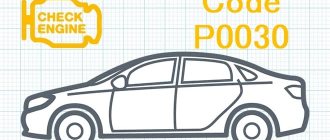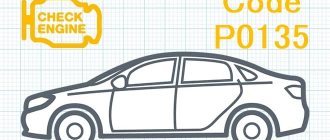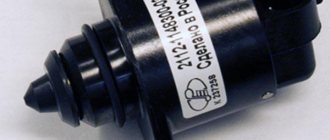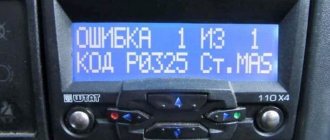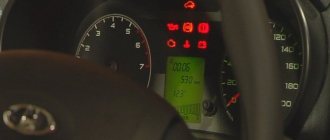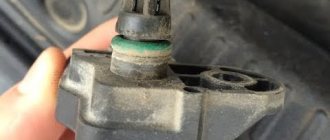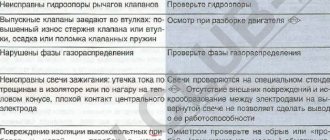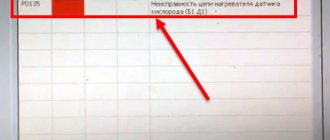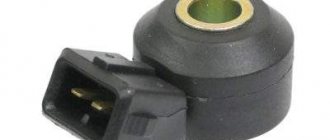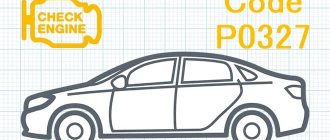Good evening, error P0650 (MIL circuit malfunction) has appeared, although the CheckEngine light lights up properly when the ignition is turned on, then goes out. There are no complaints about her. What could the brain not like? How does the brain generally determine the health of circuits? Does it measure current?
loaf, ZMZ-409, Euro-3, Mikas-11.
I turn on the ignition, reset the errors, after 3 seconds this error appears in the 'current errors', after 20 seconds in the 'confirmed' ones.
I noticed that if you disconnect + 12V from lambda No. 1, then when reading errors there is complete confusion - It will show the absence of errors, then a complete bouquet, then again empty. I'm shocked, I don't know where to dig anymore.
Good evening, error P0650 (MIL circuit malfunction) has appeared, although the CheckEngine light lights up properly when the ignition is turned on, then goes out. There are no complaints about her. What could the brain not like? How does the brain generally determine the health of circuits? Does it measure current?
loaf, ZMZ-409, Euro-3, Mikas-11.
Try checking the ground! maybe there is a bad connection somewhere
Gentlemen, tell the kettle, it looks like the controller controls the 'CheckEngine' light bulb through some kind of relay. I found 3 relays in my loaf (one under the passenger seat) and two under the driver's seat, but not a single circuit from these relays with the 'CheckEngine' light is connected. There may be more relays somewhere, maybe I didn’t find them? Email I don’t have a diagram, so I’m struggling.
UAZ-390995, ZMZ-409.1, Euro-3, Mikas-11.
Gentlemen, tell the kettle, it looks like the controller controls the 'CheckEngine' light bulb through some kind of relay. I found 3 relays in my loaf (one under the passenger seat) and two under the driver's seat, but not a single circuit from these relays with the 'CheckEngine' light is connected. There may be more relays somewhere, maybe I didn’t find them? Email I don’t have a diagram, so I’m struggling.
UAZ-390995, ZMZ-409.1, Euro-3, Mikas-11. The ECU controls the light bulb directly, there are no relays. ECU contact number for Mikas-11 58. https://2a2.ru/patriot/b_m11.html
Comrades, with the engine running, what can be done so that the controller lights up “CheckEngine”, without damaging the engine, of course. The emergency oil pressure sensor is connected directly to the MIL light.
To make the kettle light up, install the LPG without lambda probe emulators, deregulate the gas supply at idle - open it more, or turn the sensitivity on the gearbox, and give the gas more than 3 thousand revolutions a couple of times, the probability of the light coming on is 90%. :)))))))))))
in our VKontakte group
DIAGNOSE YOUR CAR YOURSELF!
When the ignition is turned on, the malfunction indicator lamp lights up continuously. When the engine starts cold, the warning lamp turns off and blinks once. If there is any malfunction in the system, the warning lamp lights up.
Conditions for the DTC to Occur
The ignition switch is in the on position.
Conditions for setting the DTC.
The ECM detects a persistent short to ground or an open in the signal circuit.
Action Taken When the DTC Sets
The malfunction indicator lamp lights up. The controller records the operating conditions at the time the fault is detected. This information is stored in a status record buffer and fault logs. An archive of diagnostic trouble codes is saved.
Conditions for Clearing DTC/Malfunction Indication
The malfunction indicator lamp turns off after three consecutive test cycles have completed without failure. The historical DTC clears after 40 heat cycles without failure. The DTC can be cleared by a scan tool.
Diagnostic guidelines
An intermittent fault may be caused by a loose connection, chafed insulation, or broken wiring under the insulation. Any circuit suspected of causing an intermittent fault should be carefully tested for the following conditions. Removed terminals Terminal connections Faulty locks Deformed Damaged terminals Loose connection between terminals and wires Physical damage to wiring harnesses
Good day! The check light is on, error 0650 VAZ 2114 Error 0650, lamp circuit malfunction, has anyone had this? what did you do? Error 0650.
Similar articles
One comment on “Error 0650. Check light Error 0650 VAZ 2114 Error 0650 lamp circuit malfunction”
I got a check because of a light bulb. Try changing the light bulb
I figured out the errors, maybe it will be useful for someone (the symptoms were the following - waste of fuel, about 23 l/100 km in winter, 2.0 L engine). After diagnosing elm, the following came out:
P0650: Malfunction Indicator Lamp (ML) Control Circuit
P0038: HO2S Heater Control Circuit High (Bank 1 Sensor 2)
(the second lambda as it turned out)
I’ll tell you right away the decoding of all this, and more specifically, what to change and adjust I searched for a long time and with little success, and the benzene oil went on as usual. finally found this: “The heated oxygen sensor (HO2S) operating range is 350 to 850°C (662 to 1562°F). By using a HO2S sensor heater, the time required to activate the fuel control is significantly reduced. The current through the heater is controlled by the PCM via a pulse width modulation control circuit. The cold HO2S sensor circuit has low resistance and carries high current. On the other hand, as the temperature of the sensor resistor increases, the current gradually decreases.”
What does this mean? as explained by friends comrades + their thoughts = 1. P0038: HO2S Heater Control Circuit High (Bank 1 Sensor 2) P0038 HO2S heater control circuit high short circuit to positive electrical heating circuit
— bank 1 sensor 2 is the 2nd lambda (clean, wash, didn’t, bought a new one) spare part code
39210 23750.
2.
P0650: Malfunction Indicator Lamp (ML) Control Circuit P0650 Malfunction in the malfunction indicator lamp (MIL) circuit;
the malfunction was due to a malfunction lambdas, voltage was supplied to the lambda, the voltage was silent, the voltage became stronger (by the way, there is such a feature that wires can come off and short-circuit to the body, so check the wiring before replacing the lambda). Well, that’s all, I’m moving on to testing it in practice))) photo of the new lambda 2, located after the catalyst, otherwise some services can make a complex replacement, the replacement is simple and inexpensive; you don’t need to unscrew anything too much. Good luck to everyone!
Diagnosis and problem solving
The first step in the troubleshooting process for any problem is to review the Technical Service Bulletins (TSBs). For known problems with a specific vehicle.
The most common cause of the P0560 trouble code is low battery voltage, as well as a problem with the charging system (faulty alternator). When checking the generator, you should pay attention to its belt. This is what often causes problems.
Battery check
Make sure the battery is fully charged and check for signs of acid buildup at the terminals. Also, check that the terminal connections are secure and clean, repair, or replace the terminals as necessary.
Make sure all electrical consumers are turned off or unplugged and check the system to ensure the battery is not drained. If a leak is detected, isolate all circuits one by one to determine the culprit and repair if necessary.
Test the battery under load and replace it if defective. Clear all codes and retest the system to ensure the fault does not return. If the battery is operating within the specifications stated in the manual. There are no faults in the wiring, proceed to checking the generator.
Generator testing
Make sure all wiring is connected, connect the OBD-2 scanner and check the generator output with the engine running. If the reading at the generator output does not exceed 14 volts, the generator may be faulty, but you need to check the wiring.
Check all primary and secondary ground connections to ensure all connections are intact. Poor grounding often leads to overheating at connection points. Therefore, check all cable lugs for signs of scorching, burning or sparking. Repair if necessary.
Please note that the alternator output should be within 14.2V when the engine is idling. And about 14.6 V when the engine speed increases.
If the code persists and there is no fault in the wiring, but the charge rate is not within the specified values, the alternator is faulty. However, this must be confirmed by a scanner. If a scanner is not available, a multimeter should be used to confirm the alternator is faulty.
Intermittent PCM fault or failure
The steps above apply to most vehicles and should resolve the P0560 code. However, if the code returns, it is likely that an intermittent fault may be present. In this case, the problem will have to be allowed to worsen before accurate diagnosis and final repairs can be made.
There is also the possibility that abnormal system voltage could damage the PCM if the PCM controls the alternator output. In this case, you need to replace the PCM, reprogram it and have the vehicle checked. To see if any codes are returned.
Causes of error P0650
The most common causes of the P0650 code are:
- Short circuit or break in electrical wires related to the CAN bus, or damage to the corresponding connectors
- Control module ground wire loose or damaged
- Malfunction of the malfunction indicator light bulb or LED
- Malfunction indicator lamp control circuit malfunction
- CAN bus fault
- In rare cases, a faulty powertrain control module (PCM)
Fault code P0560, how to find the cause?
Before starting troubleshooting, you need to check the voltage in the vehicle's on-board system and at the battery terminals. It should not be lower than 11.5 V. If the car starts, check the voltage supplied by the generator with the high beam headlights on, which should be within 13.5 - 14.5 V.
If the voltage is not normal, then it is necessary to check the tension of the drive belt or remove and repair the generator.
If the on-board network voltage corresponds to the norm, it is necessary to find the cause of the low voltage on the ECU.
To find out the reasons for the appearance, it is necessary to check the condition of the controller's power circuit and its connection to ground. To speed up the process and reduce labor costs, it is advisable to divide the chain into two parts. First, you should check the voltage value at terminal 87 of the main relay block. The voltage should not differ from the battery voltage by more than 0.5 V.
If the voltage is not normal, you need to find the place of bad contact by checking the circuit from the battery to the relay, according to the connection diagram.
If the voltage at terminal 87 of the main relay is normal, with the ignition on, check for a voltage drop at terminal 30 of the same relay and terminal 37 of the controller block. If the voltage at pin 30 is low, change the relay or eliminate bad contact in the relay block.
If there is a voltage drop at pin 37 of the controller block, it is necessary to eliminate an open or broken contact in the circuit from the main relay to the controller, according to the connection diagram.
When, after performing all the checks and work, the P0560 fault code remains active, there may be a weak contact in the plug connection of the controller or a malfunction of the controller itself.
What are the symptoms of a P0650 code?
The main symptoms of this error are:
- Storing P0650 Code in Computer Memory
- The Check Engine light illuminates, indicating a malfunction, on the vehicle's dashboard
- The Check Engine light comes on in the absence of any faults
- The Check Engine light does not light up when there is a malfunction
- Absence of any symptoms other than the P0650 error code being stored in the computer's memory
Car self-diagnosis
Before we begin to decipher the error codes of the on-board computer on the VAZ 2114 and 2115, we will talk about self-diagnosis. It must be taken into account that checking the vehicle independently and using special equipment at a service station can give different results. The equipment available to professionals will allow you to more accurately detect problems than diagnosing problems using a dashboard. Combinations of breakdowns will also be different. Nevertheless, self-diagnosis of malfunctions of the eight-valve “four” is useful.
How to view and find out about breakdowns that the control unit has recorded independently:
- First you need to sit in the driver's seat and hold down the odometer button on the speedometer.
- Then insert the key into the ignition and set it to the first position.
- After turning the key, you must release the pressed button. This will cause the needles on the speedometer, tachometer and other gauges to move quickly.
- Then you need to press the odometer key again and release it. An inscription with the firmware version will appear on the device.
- After the third press of the odometer button, the VAZ 2114 error codes will start to light up on the display.
How to reset errors yourself
After self-diagnosis of errors and elimination of their causes on a carburetor or injection engine, a malfunction message may remain on the standard panel. If the problem has been deleted, this means that the code combination remains in memory. We'll look at the description of the faults below, and now we'll tell you how to remove the code from memory. To remove it after testing the device, when VAZ 2114 errors appear, the codes themselves must be written down. After this, the daily mileage reset button is pressed again, this will clear the fault from the control unit’s memory.
Resetting the "Check Engine" error
It often happens that the instrument panel 2114 8 or 16 valves displays a check error - engine malfunction, the orange icon is on. Self-diagnosis does not always allow you to accurately check and determine how to fix such a problem. To fix the problem and find a solution, you should perform more detailed diagnostics of the car using a computer and additional equipment. Perhaps, during diagnostics, an unknown error indicates a malfunction in the microprocessor, on-board network or sensors. After the problem is fixed, the receipt may remain.
The "Check Engine" indicator indicates a problem with the engine.
How to reset the fault code:
- First, turn on the ignition; you do not need to start the car engine.
- Then open the hood. Use a wrench to loosen the bolt on the negative terminal of the battery.
- Wait about one minute, after which the battery terminal must be replaced.
- Close the hood and turn off the ignition.
- After that, turn it on again and start the car engine. If the check remains, it should go out on its own after some time. If the instructions given did not work and the solution did not help, then you need to look for the cause of the problem and fix it.
How does a mechanic diagnose a P0650 code?
When diagnosing this error, the mechanic will do the following:
- Check for P0650 with an Advanced OBD-II Scanner
- Start the vehicle and check to see if the malfunction indicator light comes on for a few seconds and goes off shortly thereafter
- Determines whether the malfunction indicator light has burned out
- Checks whether the malfunction indicator lamp is properly connected
- Visually inspect electrical wires and connectors for shorts, looseness, and damage.
- If necessary, repair or replace all shorted, broken, damaged or corroded components.
- Determines whether the malfunction indicator lamp fuse has blown
- If no problem is found, check the powertrain control module (PCM).
Symptoms of malfunction
The main driver symptom of P0560 is the MIL (Malfunction Indicator Light). It is also called Check engine or simply “check light”.
They can also appear as:
- The “Check engine” warning light on the control panel will light up (the code will be stored in memory as a malfunction).
- The red battery charging indicator is on.
- The engine stalls or has trouble starting.
- Frequent or unpredictable engine stalling.
- Increased fuel consumption.
- Harsh, erratic or unpredictable shifting of automatic transmissions.
- Incorrect instrument readings.
- Constant battery drain.
The P0560 code is quite serious because it can cause problems with the battery, starting system, or charging system. This may also affect the functioning of other vehicle systems. Therefore, if a malfunction is detected, it is recommended to eliminate the error as soon as possible.
What repairs can fix the P0650 code?
To resolve the P0650 code, you may need to:
- Replacing the malfunction indicator light bulb or LED
- Proper connection of the malfunction indicator light
- Repair or replacement of electrical wires or connectors
- Replacing fuses
- Properly connecting or replacing the control module ground wire
- In rare cases, replacing the powertrain control module (PCM)
- Clearing present trouble codes from the computer's memory and test driving the vehicle to see if the P0650 code appears again and determine if the problem is resolved
On which cars is this problem most common?
The problem with code P0650 can occur on different machines, but there are always statistics on which brands this error occurs more often. Here is a list of some of them:
- Chery
- Chevrolet (Chevrolet Aveo, Cruz, Lacetti, Silverado)
- Chrysler
- Daewoo (Daewoo Matiz, Nexia)
- Ford (Ford Transit)
- GMC Sierra
- Hyundai (Hyundai Grand Starex, Santa Fe, Solaris, Sonata, Starex, Tucson)
- Isuzu
- Iveco
- Kia (Kia Rio, Sid, Sorento, Sportage)
- Nissan
- Opel (Opel Astra, Vectra, Zafira, Corsa)
- Pontiac (Pontiac Grand Prix)
- Renault (Renault Duster)
- Rover
- Saab 9-3
- Volvo
- VAZ 2114, 2115
- Volga Chrysler
- Gazelle Business, Sable, ZMZ 405
- Lada Priora
- UAZ Bukhanka, Iveco, Patriot
You can sometimes encounter other errors with fault code P0650. The most common are the following: P0172, P0340, P1258, P1516, P1518.
Additional comments for troubleshooting P0650
It should be noted that in some vehicles the Check Engine light may not come on immediately, but only after detecting the error multiple times. For more detailed information, please refer to the vehicle's owner's manual.
Diagnosing and repairing the P0650 code can take a lot of time and effort, so if you encounter this code, it is recommended that you seek help from a qualified technician who has the necessary diagnostic equipment.
Need help with error code P0650?
The company - CarChek, offers a service - on-site computer diagnostics; specialists from our company will come to your home or office to diagnose and identify problems with your car. Find out the cost and sign up for on-site computer diagnostics or contact a consultant by phone
The error code does not match the problem - a common occurrence for VAZ
Considering the fact that the entire diagnostic system is built on fairly simple sensors, you should not expect accuracy from this option for testing cars. VAZ on-board computers often produce inadequate data that interferes with the operation of the car. This is especially often due to the use of analog components or other unofficial materials.
Maintaining and repairing your car today can be a real hassle if you only use official parts. They are sold at obviously inflated prices; not every driver is willing to pay a lot of money for factory parts. The reasons for strange error codes or information about known working nodes may be the following:
- failure only of the sensors of a certain vehicle component, and not the units themselves;
- bad fuel, which creates a lack of ignition and other engine problems reflected in VAZ error codes;
- clogged air and fuel filters, which can cause the most unexpected codes;
- independent firmware of the on-board computer with unauthorized software, which leads to changes in the subtleties of the power unit;
- Installing inappropriate parts may cause error codes to be constantly illuminated;
- a malfunction of the vehicle’s on-board computer system is the most common problem with issuing unexpected codes;
- installation of gas equipment and the lack of the necessary firmware for the computer will make operating the car completely impossible.
Such reasons are present today in almost every owner of a VAZ car. There is no desire to refuel at expensive gas stations while driving domestic vehicles. Despite the delicate “brains” and computer control systems, the Zhiguli engines perfectly digest any fuel without causing any physical problems.
Perhaps the manufacturer was in a hurry to install relatively modern diagnostic systems with hundreds of error codes, because reviews indicate maximum confusion when the codes are issued. The only benefit of such a diagnostic system is that the driver can find out in time about the presence of a breakdown in important systems of his vehicle.
Malfunction indicator lamp, circuit low voltage
- The ignition switch is in the on position.
- The ECM detects a persistent short to ground or an open in the signal circuit.
- The malfunction indicator lamp lights up.
- The controller records the operating conditions at the time the fault is detected. This information is stored in a status record buffer and fault logs.
- An archive of diagnostic trouble codes is saved.
- The malfunction indicator lamp turns off after three consecutive test cycles have completed without failure.
- The historical DTC clears after 40 heat cycles without failure.
- The DTC can be cleared by a scan tool.
Technical description and interpretation of error P0560
This diagnostic trouble code (DTC) is a generic powertrain code. The P0560 code is considered a common code because it applies to all makes and models of vehicles. Although the specific repair steps may vary slightly depending on the model.
This fault code is defined as a "voltage system failure". Set when the powertrain control module (PCM) detects abnormal voltage from the battery.
When the ignition is turned to the "ON" position, the PCM performs a check of the charging, starting and battery systems. When the engine is running, in a fully functional system, the on-board voltage should be in the range from 13.8 to 14.4 volts.
The powertrain control module (PCM) monitors the ignition circuit to determine whether the charging system is operating. If the voltage is too high or too low, a fault code will be set. This code will also appear if there is no voltage, but there should be.
This problem is an electrical fault. And readings that are below or above the programmed range will trigger a warning light on the instrument panel. Also, the P0560 error code will be stored and recorded as a fault.
VAZ (LADA) errors via OBDI protocol. Self-diagnosis.
1 — Malfunction of the engine control unit.
2 — The voltage in the on-board network is too high.
3 — Malfunction in the electrical circuit of the fuel level sensor.
4 — Malfunction in the electrical circuit of the antifreeze controller.
5 — Error in external temperature controller.
6 — Overheating of the engine (power unit)
7 — Emergency oil pressure in the engine.
8 — The voltage in the vehicle's electrical network is too low.
9 — Low battery level (battery is discharged)
12 — Malfunction in the electrical circuit of the malfunction indicator located on the instrument panel.
13 — No data (loss of communication) from the oxygen sensor (lambda probe)
14 — High signal level of the coolant temperature sensor (antifreeze).
15 — Malfunction in the electrical circuit of the coolant temperature controller.
16 — Increased voltage in the vehicle’s electrical network
17 — Low voltage in the on-board network
19 — Malfunction in the electrical circuit of the crankshaft position sensor.
21 — Malfunction in the throttle position regulator.
22 — Low signal level of the throttle position sensor
23 — High signal level of the intake air temperature sensor
24 — Malfunction in the electrical circuit of the vehicle speed sensor.
25 — Low signal level of the intake air temperature sensor
27 — Incorrect signal from the exhaust gas system sensor
28 — Incorrect signal from the exhaust gas system sensor
33 — Malfunction in the electrical circuit of the air flow meter
34 — Malfunction in the electrical circuit of the air flow meter
35 — The ECU has detected a deviation in idle speed
41 — Incorrect signal coming from the phase regulator
42 — Malfunction in the electrical circuit of the electronic ignition system
43 — Incorrect signal coming from the knock sensor
44 — The mixture in the engine cylinders is too lean or rich
45 — The mixture in the engine cylinders is too lean or rich
49 — Vacuum leak
51 — Malfunction of one of the memory modules of the control unit - RAM or PROM
52 — Malfunction of one of the memory modules of the control unit - RAM or PROM
53 — Incorrect signal coming from the exhaust gas sensor
54 — No signal from the octane corrector regulator
55 — Poor air-fuel mixture at low load on the car engine
61 — Malfunction in the electrical circuit of the oxygen sensor (lambda probe)
E - Determining an error in a data packet stored in EEPROM
Basics of error codes on VAZ cars - diagnosable components
Today, cars from domestic manufacturers across the entire model range are equipped with the necessary computer diagnostic systems. But these systems are far from ideal, and even the designers of the plant itself admit this. General sensors are used as the basis for identifying problems; these systems do not provide any specific data in the event of a breakdown.
Demonstration of problems with your car is based on some functions, so the codes cannot show the exact problem. For example, there are several sensors on the engine air supply system. Oxygen and its consumption can indeed indicate problems with the unit, but this is not always accurate. The most serious error codes that you should pay special attention to are the following:
- problems associated with the on-board electrical network - codes P0562 and P0563 indicate low and high voltage levels, respectively;
- codes P0506 and P0507 indicate incorrect idle speed settings - too low and too high speed;
- four codes indicate a malfunction in one of the cylinders - P1301, P1302, P1303, P1304;
- also four codes are responsible for malfunctions of the injectors on each cylinder - P0201, P0202, P0203, P0204;
- an extremely important code, after which it is better to stop operation - an indicator of increased engine temperature P0217;
- The P0300 code is often a harbinger of the need for major repairs, because it means random fuel misfires.
Most codes are related to the operation of sensors, because this is the easiest way to build a car diagnostic system. Nevertheless, this approach has proven to be effective for owners of domestic cars, because now you can know for sure that some kind of problem has occurred with the car. It no longer makes sense to fix the problem yourself; the car system has become much more complicated.
Therefore, after receiving information about a malfunction, it is best to visit a car service center and carry out diagnostics. Service stations never rely solely on on-board computer data. Often, an independent check of all systems is carried out and the presence of problems is determined by the behavior of the car, the owner’s testimony and other important criteria.
How to fix the problem
After diagnosis, the problem should be repaired. When reading a signal, it is necessary to check the circuit and devices following it. The most accurate method is to replace the damaged part with a known good one (new). This will eliminate the possibility of incorrect repairs. If the device is in working condition, the lines are checked; usually a primitive test is sufficient. However, if the control unit or relay fails, you will need a special tester and the ability to use it.
You can prevent this from happening in the following way.
- Check the condition of the connectors once every 5000 km. The pads should sit in place tightly, without play. If necessary, elements must be replaced with new ones.
- Check plug connectors two to three times a year for oxidation. Oxides reduce the flow of electricity through on-board wiring, which leads to incorrect display of information.
- Experts recommend purchasing and using oil for electrical terminals. The liquid is similar in composition to transformer lubricants. The formula prevents water and oxygen from reaching metals, which prevents them from rusting.
Important! You can diagnose VAZ 2114 error codes on the instrument panel and ECU yourself, only if you understand the essence of the process. If you don’t have confidence in your own abilities, it is recommended to contact a qualified technician.
https://www.youtube.com/watch?v=D9hPOhmxtEU
If you have the appropriate knowledge and the necessary equipment, you can find and correctly decipher the error codes of the VAZ 2115 injector and other elements yourself. Due to the simplicity of the car's electrical circuit, the user does not require deep knowledge of mechanics or electronics.
